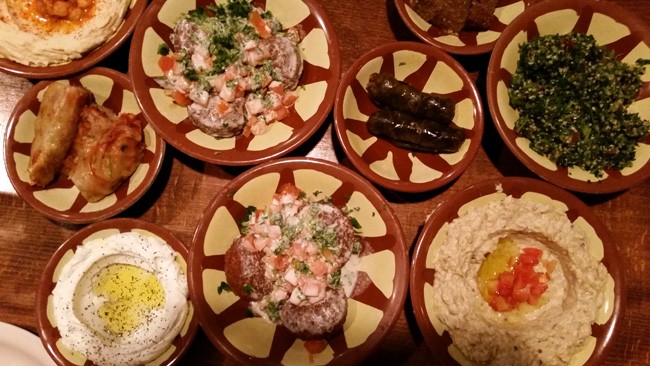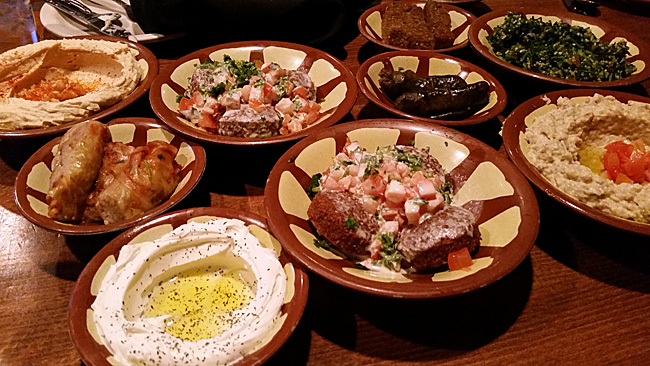
Here’s how dinner starts at a certain kind of restaurant in the Middle East: You sit down. A waiter perfunctorily notes the number of people in your party. And then dishes just start appearing. Small dishes, mostly, but heaped high. There will be instantly recognizable things like hummus and baba ghanoush and falafel. There will probably be rice and meat wrapped in grape or cabbage leaves. It goes without saying that there will be baskets of pita. But then there will be all kinds of delicious things you may not know by name — various combinations of cauliflower and eggplant and tomatoes and tahini.
Just when you’re marveling that there isn’t a single visible square inch of table left, a waiter will shift a plate or a basket to make room for one more.
And these are just the appetizers.

That is the kind of experience you can start to recreate at Beirut Restaurant in West St. Paul when you order the mezza ($40 for two). Although the wave of dishes doesn’t quite cover the table, it is just about the most celebratory way I can think of to spend a meal.
Mezza is a family-style free-for-all with big flavors on little plates. It’s a homey and welcoming ritual meal meant to be enjoyed slowly: a smear of labneh (a thick, creamy cross between yogurt and cheese), then a little conversation. A bite of kibbe (raw or baked meat mixed with grains and seasoning), then maybe a heartfelt argument about the possibilities for peace in the Middle East. “Pass the pita, dear,” then, “Whoa, is that a bellydancer?” (Saturdays at 8 p.m., yes.)
And when you’ve gallantly passed on the last falafel (denser, more uniform, and more cuminy than its Israeli counterpart) and instead wiped up the last bite of baba ghanoush (silky and beyond smoky to deliciously charred) then it’s time to let the waitress know you’d like the cook to fire up your kebabs. Yes, there’s more.

Kebabs are kebabs, and these are fairly tender and good: kafta (ground meat), chicken, and lamb. But the real reason you want to dig into them is the garlic sauce. This is the tiny little dish of almost impossibly white paste off to the side. It packs far more flavor into a couple of tablespoons than you might expect, but be forewarned: You will definitely want more. (Good news: You can buy a pint on the way out for $9.)
In theory just emulsified oil, lemon juice, salt and garlic — lots of garlic — the sauce has some kind of culinary magic behind it. We took home a pint, and I’m not ashamed to say I eventually gave up on the pretense of even crackers and just switched to a spoon.
After all that garlic and tahini and meat and vegetables, the only sensible way to end the evening is with a glass of arak, an anise-flavored liqueur, or some viscous, blisteringly hot Middle Eastern coffee. But take your time with it. A little sip. A little conversation. A little bellydancing. A little sip. And, maybe, yes, please, we’ll have that baklava after all.
Beirut Restaurant, 1385 Robert St, W St. Paul, MN, 55118; 651.457.4886


The ground meat kabob is kafta, not kibbee. It’s seasoned differently than the kibbee, most noticeably with parsley and no cracked wheat.
The proper name for the garlic sauce is toum. It’s near impossible to make at home, and one of the most wonderful things that has ever happened to charred meat. If you do bring some home, try it on a grilled burger – nothing else, just burger, toasted bun, and toum.
I am blessed that Beirut is a guest restaurant once or twice a week at my workplace. Love them!
Thanks for the correction, Eric. Typing too fast.